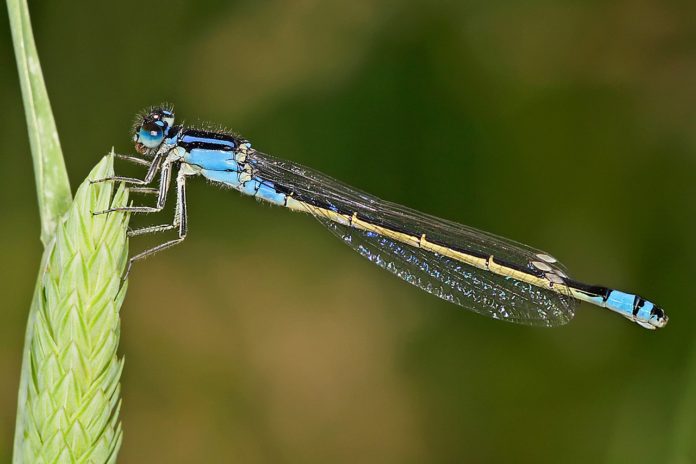by William G. Tapply
Damselflies provide exciting summertime action for a variety of game fish.
Photo by fir0002 | flagstaffotos.com.au
I thought I’d found a pond full of basking carp. Its surface lay flat and still under the blazing mid-morning Montana sun, and I spotted the big swirls and sloshes and boils from a hundred yards away when I was still bumping down the old farm road.
Well, I thought, nothing wrong with carp.
I parked under a cottonwood, tiptoed to the water’s edge, and took a peek.
Not carp. Brown trout. But they looked as big as carp. They were cruising among the reeds and along the edges of the weed beds, and every minute or so one of them would hurtle to the surface. These were not the dainty, sipping riseforms you expect from big trout when they’re eating mayflies. These were sudden and violent and lethal. Sometimes a fish’s momentum launched it entirely out of the water.
It took me a few minutes to see what they were eating.
Damselflies. They swarmed in the air and covered the reeds. Once in a while, one of them dropped to the water’s surface. Suicide.
I have subsequently learned that trout gobble adult damselflies whenever and wherever they find them, which turns out to be in July and August along the weedy shorelines of most trout ponds and lakes and in the deadwater sections of rivers and spring creeks. But at the time, my experience with damselflies had been limited to the nymphs, which I knew trout loved. This was a revelation.
I fumbled through my fly boxes. I had about a dozen of them with me, but none contained anything remotely resembling a damselfly, with its long needlelike abdomen, its laid-back transparent wings, and its brilliant neon colors.

Slender damselflies often get blown onto the water’s surface, where trout and bass will feed on them voraciously.
Photo by Jason Cotta
I did finally manage to catch one of those trout on a trimmed-down green drake pattern, but I knew it was an aberration. What bugged me was all the trout I didn’t catch. They were absolutely frenzied, but they wouldn’t even look at hoppers or beetles, my standard go-to dry flies on trout ponds when the Callibaetis aren’t hatching. Those Montana fish wouldn’t eat anything but damselflies.
That evening, I stopped at a local fly shop and told the clerk about my discovery. He shrugged, allowed as how the damselfly hatch was a major event on many western trout ponds, and showed me the deer-hair pattern that they carried. I bought half a dozen, and the next morning I went back to that pond and enjoyed one of those rare and memorable trout orgies. By mid-afternoon, I’d left every one of my store-bought damsels in the jaw of a big trout.
When trout are up on damselflies, they can be pretty picky. I’m convinced that a close imitation provokes many more takes than a merely suggestive approximation does. Few things are more disheartening than watching a 20-inch trout spot your fly, accelerate toward it, and then slam on the brakes, stare at it from a distance of about an inch, shrug, turn, and swim away. When damselflies are hatching, you want to have confidence in your fly.
Damselfly fishing is generally best from mid-morning through mid-afternoon from late June, when the nymphs hatch into adults, through much of the summer. Electric blue seems to be the most common color, but I’ve encountered red, green, olive, and tan damsels. The most exciting and productive method is sight-fishing for cruisers on a bright, sunny, flat-calm day. Good polarizing sunglasses are as important as good flies. A soft breeze that barely riffles the surface makes it a little harder to see into the water but easier to stalk the fish without spooking them. The fish seem a bit less persnickety when the surface is riffled, too.
A 5- or 6-weight outfit with a weight-forward floating line is about right, both for casting a somewhat air-resistant fly and horsing big fish out of the weeds. You don’t need a particularly long or fine leader. Twelve feet tapered to 4X does the job. Finer tippets won’t turn over the fly, nor will they enable you to land large trout quickly enough to avoid exhausting them.
Perhaps the most vital items for sight-fishing with damselflies are a wide-brimmed hat and a good pair of polarizing sunglasses. Amber lenses maximize contrast and enable you to spot fish under the surface.
A float tube is ideal for this kind of fishing. Whenever possible, though, I prefer to stay out of the water and creep along the bank. When I spot a trout, I try to predict its route and drop my fly 10 or 12 feet ahead of the fish. Rather than pick up and cast again if I see the trout start to change direction, I give the fly a little twitch. As often as not, the fish turns and comes charging.
Editor’s note: When I was the editor of American Angler, I had the pleasure of working with William G. Tapply for ten years before his death in the summer of 2009. He was far and away the best writer I have edited, and we developed a friendship around our shared angling and literary interests. He wrote books and articles on fishing and hunting, as well as great mystery novels that often featured fly-fishing. For a list of great books by William G. Tapply (many available on multiple formats including iPad, Kindle, Mobi, etc.), click here. Don’t miss Sportsman’s Legacy: A Rich Memoir of a Man’s Life with His Great Sportsman Father, His Beloved Family, and His Adored Brittany.
Credit: Source link





























